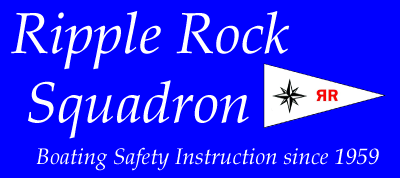Navigation Lights - More Advanced: Towing, Fishing, Diving and Rescue/Enforcement
Caution:
- The following information has been simplified so we can give you a basic introduction using (mostly) non-technical language. Review the actual Regulations for in-depth information (we have noted the rule number, in square brackets, where practical). The Regulations can be found on our links page.
- A lot of effort has been made to ensure the information is correct, but errors may occur (If you find one please leave a message for our Webmaster).
- This information is intended for boaters on the BC Coast; it does not address modifications for vessels operating in the Great Lakes Basin.
Towing vessel less than 50m in length, towing astern, length of tow less than 200m
[Rule 24]

- The second masthead light, from ahead looks much like the second masthead of a power driven vessel of over 50m
Towing vessel less than 50m in length, towing astern, length of tow greater than 200m
[Rule 24]

- A third masthead is shown if the length of the tow exceeds 200m
- In daytime, the towing vessel must show a diamond shape where it can best be seen. [Rule 24 a (v)]
Towed vessel or object
[Rule 23]

- Note the absence of masthead light
- If multiple vessels are under tow, they must all display these lights.
Towed barge (Canadian Modification)
[Rule 24 j]

- This configuration is allowed under the Canadian Modifications. It is becoming less common with good quality Solar LED nav lights for barges available now. So more likely to see sidelights and a sternlight.
- Technically, these lights are only supposed to be shown in harbours, roadsteads, etc. but may be found anywhere on the BC Coast
Log tows (Canadian Modification)
[Rule 24 m]

- The diagram shows a tow of more than 25m in breadth, by more than 100m in length (if less than 25m in breadth and less than 100m in length only show 1 light at each end)
- This is a common sight around Campbell River. Older kerosene lamps were difficult to spot, and often were extinguished in a chop (and booms are difficult to spot with radar in a chop). The new LED lights work much better.
Diving
[Rule 27 (e) and (g)

- Dive vessels are considered to be restricted in manoeuvrability (see advanced section), and even small vessels, while conducting dive operations at night are required to show the restricted lights. Night diving is seldom done in this area. But lots of diving is done by day.
- They are also supposed to use standard restricted in manoeuvrability day shapes, but if not practical, they may use the international "Alpha" flag (white and blue swallowtail above), visible all round.
- The red, with white diagonal stripe, diving flag is supposed to be used only on a buoy, but may be seen on vessels.
- Divers may get swept by the current in our local passages, and when they surface they may be very difficult to spot. Always keep a good watch on the water down current of dive operations.
Government vessel engaged in Rescue or Law Enforcement
[Rule 45]

- The star shape represents a flashing blue light. Its position likely will differ from shown, but should be visible from all round.
- The vessel is still required to abide by the collision regulations (in this case considered a power driven vessel)
